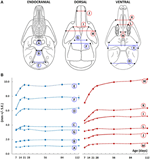

The iliac bone vascularization is maintained by circumflex arteries including the deep, lateral, superficial ones, epigastric superficial inferior and superior gluteal artery, and branches. It allows immediate reconstruction that avoids contour distortions of the mandible.
CRANIOFACIAL SKELETON SKETCH FREE
The iliac crest composite free flap has proven to be the one of the most effective and reliable choice for oromandibular reconstruction due to its appropriate and sufficient bone volume and corticocancellous structure and shape. Various factors must be considered such as localization, residual bone dimensions with or without soft tissue defects, vessels, and bone volume for dental implant rehabilitation, when deciding which flap is the most suitable. Iliac crest and the fibula are the most favorable donor sides for oromandibular reconstruction with the advantages of minimal donor site morbidity, optimum pedicle length and diameter and two team approach. Recently, the use of vascularized osteocutaneous free flaps has decreased the morbidity and mortality percentages, especially since the oncological cases and osseointegrated dental implants that are installed on these flaps help to improve postoperative masticatory function.

However, for larger defects after trauma or neoplasm surgery for the vitality of the bone and soft tissue of the graft is still challenging. The use of non-vascularized bone grafts and modified approaches for reconstruction of atrophied mandible prior to dental implant and dentures is well defined in literature. Today, mandible can be reconstructed via non-vascularized bones or different types of free flaps in association with stock or 3D custom-produced titanium screws and plates. The esthetic outcomes would have balanced facial harmony with symmetry and vertical dimension. Anatomic reconstruction requires adequate three-dimensional maxillomandibular relation. The functional considerations would include the restorations of occlusion, fonation, mastication and swallowing. Therefore, reconstruction of the mandible requires to restore all the functional, anatomic, and esthetic aspects. It creates the boundaries of fossas (submandibular, sublingual, submental, infratemporal, pterygomandibular, submasseteric, and so on) as well. It includes and neighbors the temporomandibular joint, glenoid fossa, teeth, muscles, ligaments, salivary glands, and the tongue.

Mandible is the most dynamic part of the of the oral and craniomaxillofacial region. Interpositional bone grafting from left mandible to the right side. Because cranial bone grafts are composed of membranous bone, it is felt that they retain their bulk better than other types of bone grafts do, especially if they are rigidly fixed. If vascularized free bone flaps and nonvascularized iliac bone grafts for mandibular reconstruction are eliminated, cranial bone grafts are the gold standard for use in the craniofacial skeleton. However, alloplastic materials have been abandoned as they are associated with a high risk of complications such as migration, infection, and underlying bone resorption. In the past and currently, alloplastic and other autogenous materials have been used to reconstruct the craniofacial skeleton.

Several studies have described the cranial bone grafting procedure that is preferred by most craniofacial surgeons worldwide. Most of the craniofacial surgeons accepted that bony defects of the face must be reconstructed with bone and soft tissue defects must be reconstructed with soft tissues. Craniofacial bone grafting plays an important role in the reconstruction of the craniofacial skeleton.


 0 kommentar(er)
0 kommentar(er)
